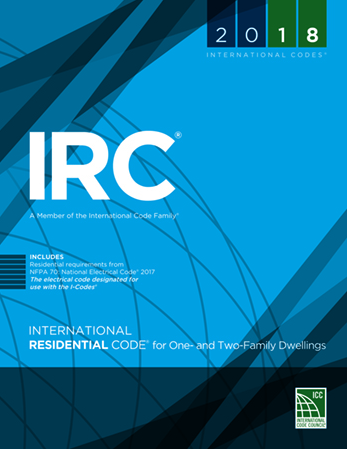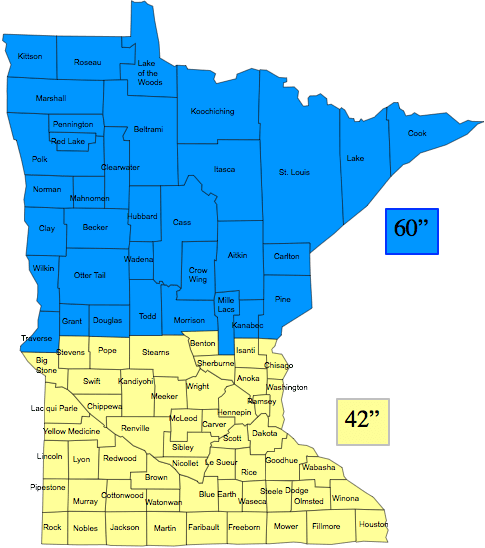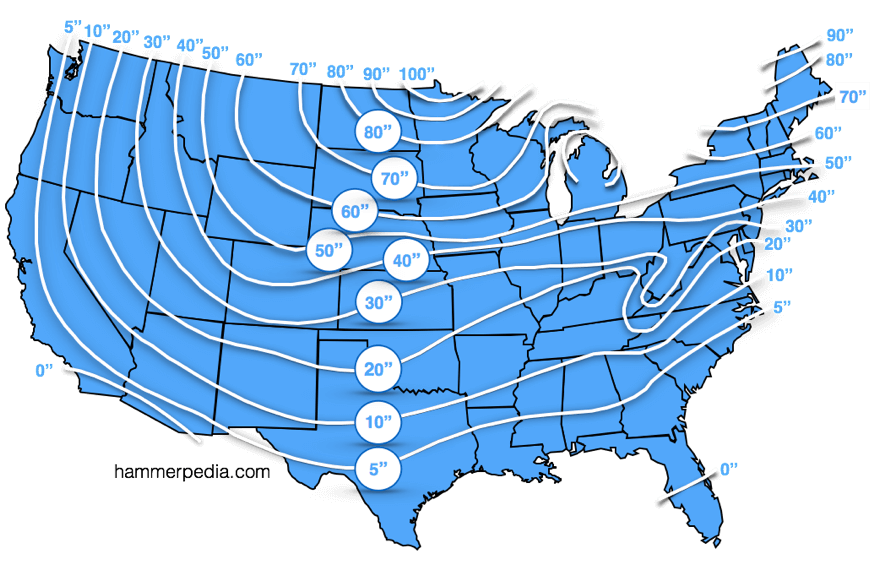Full Frost Wall Foundation?
Reader AARON in ROSEVILLE writes:“Assuming (not yet verified) that I don’t need a full frost wall foundation for my barndo, wondering about the pros/cons for full frost wall vs pier footings in southern MN. Obviously there is the cost difference, but when it comes to building performance(in the winter), would you recommend frost wall over pier footings? And are there any work arounds to improve the cold weather performance of a pier footing?”
Mike the Pole Barn Guru responds:
When we built our post frame barndominium in NE South Dakota 16 years ago, we could have utilized any foundation type we wanted. We opted for embedded columns and have had absolutely no regrets about our choice.
From a standpoint of both Code requirements, as well as performance over time, there is not a structural reason to use a full frost wall for a post frame barndominium.
Any heated structure should be meeting the most recent edition of ICC’s (International Code Council) 2021 IECC (International Energy Conservation Code), even if not required in your jurisdiction (usually due to either no structural permit requirements or not yet adopted). You can look up your county’s Climate Zone at: www.codes.iccsafe.org/content/IECC2021P2/chapter-3-re-general-requirements. Once you know your Climate Zone, Chapter 4 will guide you through insulation requirements for roofs/attics, walls and floors.
In Minnesota, Code requires slab edges to be insulated down four feet with R-10 insulation. With post frame construction, you can rip 4′ x 8′ sheets of R-10 EPS in half lengthwise. Attach lengthwise to the inside of pressure preservative treated splash plank (aka skirt board or bottom girt) with top of insulation even with eventual top of concrete slab. Balance of requirement is solved by using another two foot piece horizontally at the bottom of vertical insulation (basically forming an insulation “L”). This does require digging a trench, however one would need to be dug (and far deeper) for a concrete foundation wall.
Now your challenge….how to insulate piers. Whether using embedded columns with a concrete footing/bottom collar, or full concrete piers with wet set brackets, you can build square forms out of EPS. It does mean you will have excess insulation on the under slab side of the pier, but it is a viable and cost effective solution.
Best way to ensure a successful outcome is with really great site preparation. If you would kindly visit our website www.HansenPoleBuildings.com and navigate to SEARCH in the upper right corner. Type in SITE PREP and hit ENTER. Up will come a plethora of relevant articles for your reading pleasure.
Tag Archives: IECC
Information on Codes and Shouses
I have to admit it was rather flattering to have Southwest Iowa’s Planning Council reach out to me regarding information on Codes and Shouses recently.
“Hello. My name is Ashley and I’m a community development specialist with Southwest Iowa Planning Council out of Atlantic, IA. I am currently working on some Zoning and Building codes for smaller towns and they want to include zones and/or building codes for shouses. Since this is relatively new to this area, within city limits at least, I was curious what issues your company has come across regarding codes and if you had any sample codes from communities that you would be willing to share with me?”
Mike the Pole Barn Guru responds:
Thank you for reaching out to us. We have provided hundreds of post frame shouses and barndominiums in nearly every state. Good news for you (and these jurisdictions) is this project will involve very little extra efforts beyond what is currently in place.
Use of terms such as “pole barn”, “pole building” or “post frame” home, barndominium, shouse or shop/house oftentimes cause permitting waters to become clouded – yet they need not be.
From a Zoning/Planning standpoint – shouses (I will use this as an all encompassing term) should be treated no differently than any other code compliant structural system. Any existing requirements for setbacks, footprint requirements, heights, living area to garage/shop ratios, siding and/or roofing materials, color restrictions, etc., should remain the same as currently adopted. What is important is to not place restrictions upon shouses not existing for other dwellings, as this could end up leading to costly and protracted legal battles.
Currently adopted Building Codes (IRC, IBC, IECC) do not have to be amended for shouses.
In “Effective Use of the International Residential Code”:
Paragraph 4:
“It is important to understand that the IRC contains coverage for what is conventional and common in residential construction practice. While the IRC will provide all of the needed coverage for most residential construction, it might not address construction practices and systems that are atypical or rarely encountered in the industry.”
 IRC R301.1.3 Engineered design.
IRC R301.1.3 Engineered design.
“When a building of otherwise conventional construction contains structural elements exceeding the limits of Section R301 or otherwise not conforming to this code, these elements shall be designed in accordance with accepted engineering practice. The extent of such design need only demonstrate compliance of nonconventional elements with other applicable provisions and shall be compatible with the performance of the conventional framed system. Engineered design in accordance with the International Building Code is permitted for all buildings and structures, and parts thereof, included in the scope of this code.”
In summary (and in my humble opinion), any shouse outside of IRC prescriptive requirements, should be designed and have structural plans signed by a Registered Design Professional (architect or engineer) to meet or exceed jurisdictional climactic conditions.
Please feel free (or direct any jurisdiction) to reach out to me directly with any questions or concerns.
Engineer Andy Ponders Insulation and Condensation
Loyal (and prolific) blog reader ANDY in OXFORD writes:
“First, THANK YOU for providing so much valuable information in your blog, free of charge. I’m an engineer, quite handy, with construction experience. But everything I know about post frame construction, I learned from you. I’ve been planning for over a year, and I’ve read your first 1700 or so blogs. I’m about to place an order with Catherine Suarez, (she’s been very patient, by the way) for a 30x36x11. 6/12 roof with vented soffits and ridge, gable overhangs, and dripstop on roof steel. Location is north Mississippi, 30’s in winter, 90’s in summer with 60% to 80% humidity any time of year. It will be used as a dedicated woodworking shop, heated just above ambient in winter (except when I’m working there) and cooled only when I’m out there (rarely) in summer. I know you must get tired of insulation/condensation questions because you get so many of them. But it’s not something that’s intuitive to most of us. It’s the thing I’m least confident about. And I HATE rusty cast iron. I plan to install plywood or OSB ceiling with blown insulation above. House wrap between wall steel and girts (I would have never thought of house wrap), and craft-backed insulation between the commercial girts. Oh yes, and a good vapor barrier under the slab. So my question is . . . is this sufficient? What would Mike do??Thanks again for what you do.”

Mike the Pole Barn Guru writes:
Thank you very much for your kind words, they are greatly appreciated. If I ever have to give a technical presentation on post-frame buildings, can I recruit you for my front row?
Post frame construction appears so simple at first glance, yet is highly technical and (like most things) it is in the details where they either work as expected or fall flat (literally). A set of calculations for even a simple rectangle can easily run over a hundred pages in verifying every member and connection!
Catherine is a dream. I love her clients as they know exactly what they are investing in and it makes for an extremely smooth process for all involved.
For some reason insulation and humidity are crucial areas seemingly left as an afterthought in far too many builds, often when it is too late to make economically sound corrections.
Lafayette County, Mississippi is in Climate Zone 3A (for reference). If you were building for a residence, 2021’s IECC (International Energy Conservation Code) would have R-49 ceilings, R-20 walls and R-10 slab perimeter insulation down two feet.
What would I do?
Even though you are probably not doing radiant in-floor heat, I would lay R-10 EPS insulation sheets on top of a well sealed under slab vapor barrier. If not, when it is 90 degrees F. and 80% humidity, the dew point is 83 degrees F. Your soil temperature could well be less than 70 degrees F., meaning you will have a damp floor from condensation.
For walls, a Weather Resistant Barrier and bookshelf girts are both winners in my book! I have become a proponent of rock/stone/mineral wool unfaced batts as they remain unaffected by moisture (and humidity) with a well-sealed 6mil clear poly vapor barrier inside. You have probably read this article: https://www.hansenpolebuildings.com/2013/03/roxul-insulation/
Ceiling – I do still like blown in fiberglass for value vs. return. I would specify 18 inch energy heel trusses to allow for full thickness of R-49 insulation from wall-to-wall, in conjunction with vented eaves and ridge.
You will want to make certain you order a well insulated and wind-rated overhead door for your woodworking shop. Keep in mind, door manufacturers do tend to stretch reality with their insulation claims https://www.hansenpolebuildings.com/2017/02/high-r-value-overhead-doors/.
Concrete Slabs on Grade for Cold Climates
My lovely bride and I have a shouse (shop/house) in Northeast South Dakota, where it can tend to get chilly in Winter. Reader TERRI in DULUTH is in a similar situation and writes:
“What type of slab for cold climates do you recommend?”
Well Terri, thank you for your patience in awaiting a response, your email address was not included with your question, so I was unable to message you back as quickly as I would have liked.
PLEASE – If writing an “Ask the Pole Barn Guru” question include your email address.
Injecting some humor (sadly, I have to point it out as not everyone gets it) – I would recommend a concrete slab.
Before diving into this subject – accept one fact, concrete slabs will crack. If you are expecting otherwise, you are setting yourself up for disappointment.
First key to a successful slab is excellent site preparation: https://www.hansenpolebuildings.com/2017/02/building-site-preparation/
Second – insulate your slab’s perimeter. 2021’s International Energy Conservation Code (IECC) provides guidance to meet energy code requirements for every county within our country. Begin by looking up your Climate Zone: https://codes.iccsafe.org/content/IECC2021P1/chapter-3-re-general-requirements
I will cheat and tell you Duluth (St. Louis County) is climate Zone 7.
Scroll down to Table R402.1.3 to find Insulation Minimum R-Values.
In Climate Zone 7 your slab perimeter must be insulated to R-10 and be four feet in depth.
Weirdly enough, Minnesota’s Building Code only requires footings to be at 60 inches of depth in your area (https://www.revisor.mn.gov/rules/pdf/1303.1600/2015-01-23%2012:37:31+00:00).

Although actual frost depth in your area is more like 80” in depth:

I would probably look at augering holes no less than 72 inches in depth, using a bottom collar of 18 to 24 inches (per your engineered building plans). This would allow you to trench between building columns and install R-10 rigid insulation along your building’s perimeter to a depth of four feet.
If you are going to do radiant in-floor heating you should be placing R-10 beneath your slab and on top of a vapor barrier of no less than 6 mil visqueen (I prefer 15 mil thickness to reduce chances of perforations during pouring).






